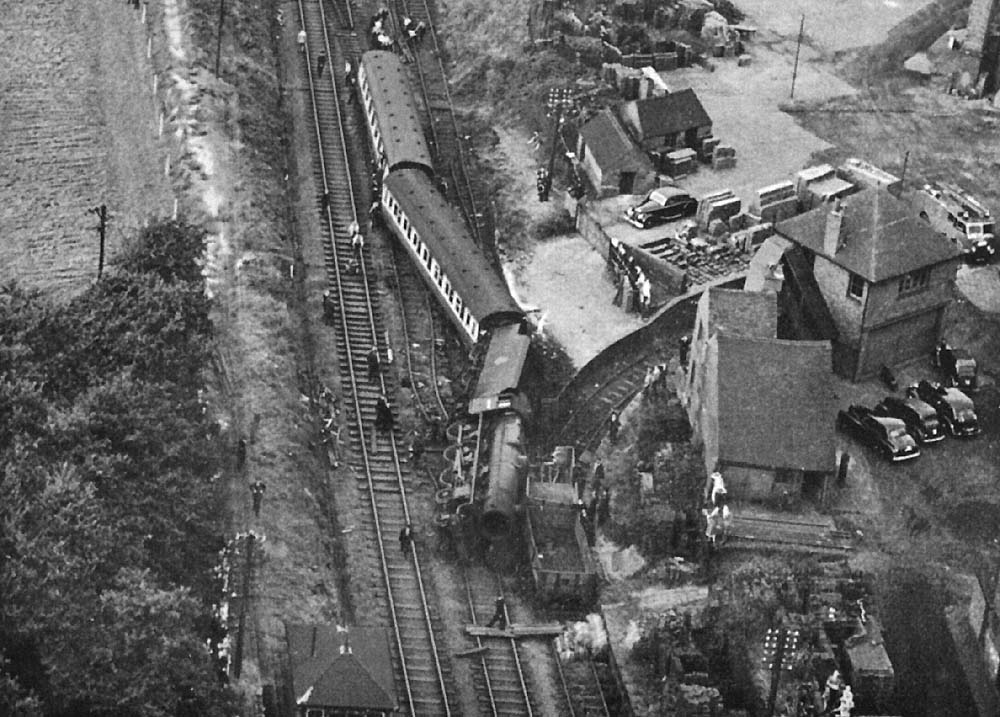 |
|
London North Western
Railway:

Midland
Railway:

Stratford
Midland Junction Railway
|

|
LMS Route: Birmingham New Street to Tamworth
Wilnecote Station: mrw1103a
 |
Close up of image 'mrw1103' showing the severely damaged railway
track and the locomotive No 45699 'Galatea' lying on its side. Colonel Reed's
reported noted 'The first mark of derailment was found on the left hand rail
510 yards beyond the 27th mile post. There was a shallow diagonal groove across
the table of the rail from inside to outside in the direction of travel, 26
feel 5 inches long and deeper at the end than at the beginning. The first chair
beyond the groove was marked on the outside but was unbroken; the remaining
five chairs before the left hand joint were broken at the outside jaws. Over
this rail length the right hand rail was slightly battered with a burr on the
running edge, and the left hand rail was slightly worn on the running edge
which was very smooth and even. The gauge was one eighth of an inch slack just
before the point of mounting and the cross level was correct'. At the left hand
rail joint 15 feet beyond the end of the diagonal groove the four fishbolts had
been sheared off by a sharp impact on the outside nuts, and the fishplates had
fallen away. The rail beyond this joint had fallen on its side as all the
chairs were broken; it had also been driven forward 2 feet 7 inches and the
running on end had evidently received a severe blow. This rail was still
connected to the rail ahead of it and was not bent. The right hand rails were
in position for two lengths beyond the severed joint, but beyond that the whole
track was broken up for the 260 yards to the diamond crossing at Cliff Sidings,
and was damaged for 60 yards beyond.
On the approach side of the diamond crossing there were marks on
the sleepers of derailment to the right as well as to the left. The marks
furthermost to the right appeared on the ends of the sleepers of the up line
over a distance of 40 feet, beginning at 57 yards before the first 'V' of the
diamond crossing and been again over 10 feet about 22 yards before it. At this
diamond the splayed end of the check rail on the down line opposite the 'V' had
been struck and twisted outwards, and the 'V' was bulged and scored on the
outside edges of the rails as if the wheels derailed to the right had been
guided into the back of the 'V' and had been lifted on to the track by it. The
rails across the down line had been violently distorted to the right, and the
up line had been forced outwards. Ahead of the diamond the down line
immediately behind where the engine stopped had been ploughed up and pushed
violently to the right, breaking the right hand rail and pushing out the Up
line. There was such damage to this diamond crossing generally and to the
connection with the adjacent siding, but the flat bottom track had withstood
the impacts of the derailed vehicles much better than the bull-head track.
The stonework on the return wall of the Cliff Sidings dock was
chipped for about 3 feet before the beginning of the coping which had been
scored for 40 feet by the tender sliding along it. The track showed evidence of
unsteady running for some distance before the site of derailment. At 100 yards
past the 27th mile post the right hand rail was rubbed bright along the running
edge for about 5 feet. At 133 yards the left hand rail was rubbed bright along
the running edge for about 40 feet. From there up to 400 yards bright marks
were visible on both rails, the length of each mark varying between 5 feet and
45 feet without any clear pattern being apparent in the relation between the
marks on the two rails, although they did alternate to some extent. The last
five of these marks, none longer than 16 feet, overlapped the first two of
twelve lateral distortions in the track which started at about 367 yards beyond
the 27th mile post. The distortions were small, none exceeding ¾ inch,
and occurred alternately to the right and to the left of the alignment with an
average pitch of about 76 feet. The distortions to the right were less than
those to the left as might be expected as the resistance to lateral thrust of
the ballast between the up and down lines would be greater than that of the
ballast on the cess shoulder. The last distortion to the right was at its
maximum about 23 feet before the beginning of the diagonal groove, and the last
to the left about the end of the groove, the distance of this half pitch being
about 50 feet, so far as could be judged owing to the damage".
 back back

|
